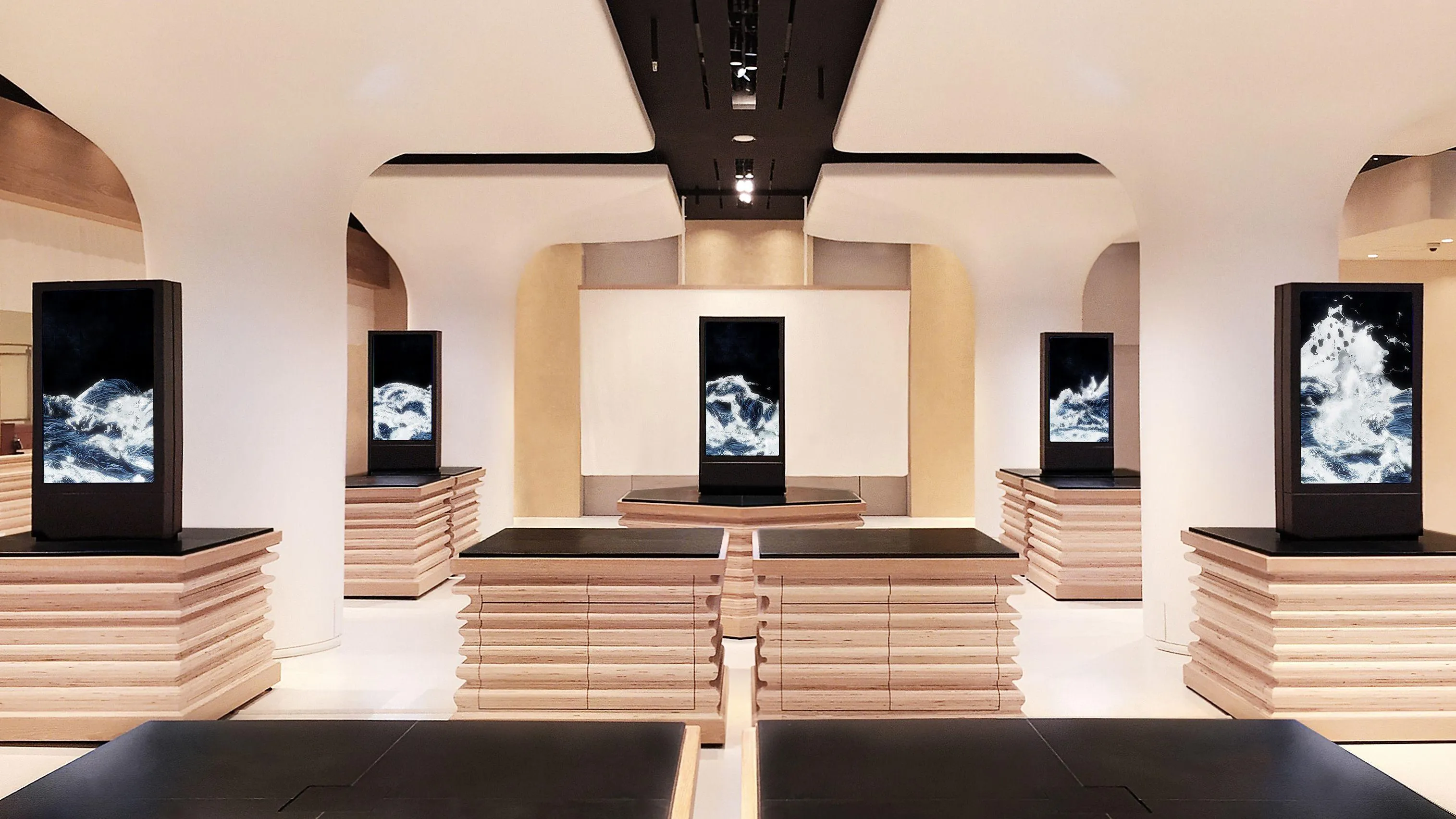
Black Waves, 2 sets of 5 screens
teamLab, 2016, Digital Installation, Continuous Loop
The movement of waves of water is simulated in a computer-generated three-dimensional space. The water is expressed as a continuous body after calculating the interactions of hundreds of thousands of particles. To express the waves, the behavior of the particles at the surface of the water was then extracted and lines were drawn in relation to the movement of the particles. The 3-D wave created in a 3-D virtual space is then turned into an artwork in accordance with what teamLab refers to as "Ultra Subjective Space."
In pre-modern Japanese painting, oceans, rivers, and other bodies of water were expressed as a series of lines. These lines give the impression of life, as though water was a living entity.
Did people in pre-modern times see the world (oceans, rivers and other bodies of water) as a living entity made up of a collection of lines just as depicted in classical Japanese painting?
This form of expression causes us to question why pre-modern people sensed life in rivers and oceans. Also, why did they behave as if they themselves were a part of nature? Perhaps something can be discovered by fusing the fixed objective world of today’s common knowledge with the subjective world of pre-modern people.
On viewing this artwork, regardless of the fact the waves are a reproduction of a physical phenomena, if we feel a sense of life in the collection of lines, what can be called the subjective world of pre-modern people, then perhaps this is one aspect of objective recognition, and there is a different side to the the modern objective world view.
If when viewing this artwork, as opposed to waves shot with a video camera, people feel that the barrier between themselves and the waves disappears, they feel immersed in the work, perhaps even feeling life in the collection of lines, and that the waves are luring them in, then perhaps we can find a connection to the way pre-modern Japanese people perceived the world and consequently behaved towards the world.
If we regard ourselves as a part of nature, and that nature is not something just to be observed, as people of old perceived rivers and oceans as a living entity of which they were a part of, then it is a way of seeing the world that lures us in and allows us to feel that there is no boundary between ourselves and nature, removing the boundary between us and nature.
In pre-modern Japanese painting, oceans, rivers, and other bodies of water were expressed as a series of lines. These lines give the impression of life, as though water was a living entity.
Did people in pre-modern times see the world (oceans, rivers and other bodies of water) as a living entity made up of a collection of lines just as depicted in classical Japanese painting?
This form of expression causes us to question why pre-modern people sensed life in rivers and oceans. Also, why did they behave as if they themselves were a part of nature? Perhaps something can be discovered by fusing the fixed objective world of today’s common knowledge with the subjective world of pre-modern people.
On viewing this artwork, regardless of the fact the waves are a reproduction of a physical phenomena, if we feel a sense of life in the collection of lines, what can be called the subjective world of pre-modern people, then perhaps this is one aspect of objective recognition, and there is a different side to the the modern objective world view.
If when viewing this artwork, as opposed to waves shot with a video camera, people feel that the barrier between themselves and the waves disappears, they feel immersed in the work, perhaps even feeling life in the collection of lines, and that the waves are luring them in, then perhaps we can find a connection to the way pre-modern Japanese people perceived the world and consequently behaved towards the world.
If we regard ourselves as a part of nature, and that nature is not something just to be observed, as people of old perceived rivers and oceans as a living entity of which they were a part of, then it is a way of seeing the world that lures us in and allows us to feel that there is no boundary between ourselves and nature, removing the boundary between us and nature.